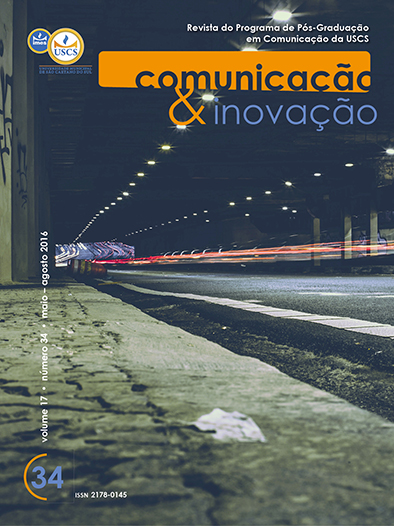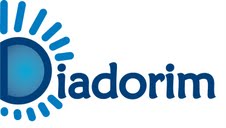Internet das Coisas e sistemas inteligentes no jornalismo: o conceito de presença diluído entre as narrativas da complexidade urbana
DOI:
https://doi.org/10.13037/ci.vol17n34.3769Palavras-chave:
Internet das Coisas. Narrativas digitais. Realidade virtual.Resumo
Este artigo discute a capacidade de integraçãode redes e fluxos informativos no ambientedas cidades a partir de sistemas inteligentes nosuporte ao processo de produção jornalística.Partindo de uma hierarquia expandida de emissores,que inclui entes não humanos conectadosa partir da categoria que se convencionouchamar de Internet das Coisas (IoT), apresentamoso modelo de jornalismo de inserção e suapossível utilidade para aumentar a percepção derelevância entre os consumidores de conteúdo,permitindo também a exploração de novas formasnarrativas. O trabalho relata ainda a iniciativa,ora em andamento, de transpor o modeloteórico descrito em uma prova de conceito aplicadachamada de projeto Jumper, um ambienteimersivo para a distribuição de notícias, suportadopor ambientes urbanos com alta densidadede conexões.
Downloads
Referências
BONACICH, P.; LU, P. Introduction to mathematical sociology. New Jersey: Princeton University, 2012. DOI: https://doi.org/10.1515/9781400842452
BANKS, A. 2014 Brazil Digital Future in Focus: revisão de 2013 & insights para 2014. São Paulo:
comScore, 2014. Disponível em: <http://agenciamarketingdigital.net/blog/2014_Brazil_Digital_
Future_in_Focus_PT.pdf>. Acesso em: 17 jun. 2016.
CONSUMO da internet pelos jovens brasileiros cresce 50% em dez anos, aponta IBOPE Media. Ibope, 28
jul. 2014. Disponível em: <http://www.ibope.com.br/pt-br/noticias/Paginas/Consumo-da-internetpelos-jovens-brasileiros-cresce-50-em-dez-anos-aponta-IBOPE-Media.aspx>. Acesso em: 18
maio 2015.
DIXON, C. What millennials want from TV. NScreenMedia, 2014. Disponível em: <http://www.nscreenmedia.com/wp-content/uploads/nScreenMedia-millennials_final.pdf>. Acesso em: 18 maio 2015.
DUBLON, G.; PARADISO, J. Extra sensory perception: how a world filed with sensors will change the
way we see, hear, think and live. Scientific American, v. 311, n. 1, p. 36-41, jul. 2014.
FEENBERG, A. Transforming technology: a critical theory revisited. New York: Oxford University, 2002. DOI: https://doi.org/10.1093/oso/9780195146158.001.0001
______. Between reason and experience: essays in technology and modernity. Cambridge: MIT, 2010.
IAB BRASIL. Brasil conectado: hábitos de consumo de mídia - 2014. 2014. Disponível em: <http://pt.slideshare.net/skrol/pesquisa-brasil-conectado>. Acesso em: 18 maio 2015.
39 Comunicação & Inovação, PPGCOM/USCS
Internet das Coisas e sistemas inteligentes no jornalismo
v. 17, n. 34 (21-39) maio-ago. 2016 DOI: https://doi.org/10.1055/s-0036-1594353
JENKINS, H. et al. Confronting the challenges of participatory culture: media education for de 21st century.
Massachusetts: MIT, 2009. Disponível em: <http://www.amazon.com/Confronting-ChallengesParticipatory-Culture-Foundation-ebook/dp/B0030DFWZM/ref=sr_1_6?s=digitaltext&ie=UTF8&qid=1391986053&sr=1-6&keywords=henry+jenkins>. Acesso em: 23 abr. 2014.
LOFGREN, K. 2015 video game statistics & trends: who's playing what & why? Big Fish Games, 3 mar.
2015. Disponível em: <http://www.bigfishgames.com/blog/2015-global-video-game-stats-whos-
-playing-what-and-why/>. Acesso em: 20 maio 2015.
MANOVICH, L. The language of new media. Massachusetts: MIT, 2001. DOI: https://doi.org/10.22230/cjc.2002v27n1a1280
MCLUHAN, M. Os meios de comunicação como extensões do homem. São Paulo: Cultrix, 2007.
MITCHELL, M. Complexity: a guided tour. New York: Oxford University, 2009. DOI: https://doi.org/10.1093/oso/9780195124415.001.0001
MORIN, E. Introdução ao pensamento complexo. 4. ed. Porto Alegre: Sulina, 2005.
NEWZOO. Global Games Market Report - 2013. 15 jul. 2013. Disponível em: <http://www.newzoo.com/
infographics/global-games-market-report-infographics/>. Acesso em: 18 maio 2015.
RYAN, B.; GROSS, C. The diffusion of hybrid seed corn in two Iowa communities. Rural Sociology, v. 8,
n. 1, p. 15-24, 1943. DOI: https://doi.org/10.1080/0005772X.1943.11094170
RÜDIGER, F. Introdução às teorias da cibercultura: tecnocracia, humanismo e crítica no pensamento
contemporâneo. 2. ed. Porto Alegre: Sulina, 2007.
STATISTA. Average daily media use in the United States from 2010 to 2014 (in minutes). 2016. Disponível
em: <http://www.statista.com/statistics/270781/average-daily-media-use-in-the-us/>. Acesso em:
18 maio 2015.
VAN DIJCK, J. The culture of connectivity: a critical history of social media. New York: Oxford, 2013 DOI: https://doi.org/10.1093/acprof:oso/9780199970773.001.0001
Downloads
Publicado
Edição
Seção
Licença
Direitos autorais (c) 2016 Márcio Carneiro dos Santos

Este trabalho está licenciado sob uma licença Creative Commons Attribution-NonCommercial-NoDerivatives 4.0 International License.
Conforme consta nas normas da revista, o envio de artigos e textos solicitando a apreciação com a finalidade de publicação na Comunicação & Inovação, configura a cessão de direitos autorais.
No caso de fotos e imagens, o autor deve providenciar documento que ateste a permissão em termos de direitos autorais.





